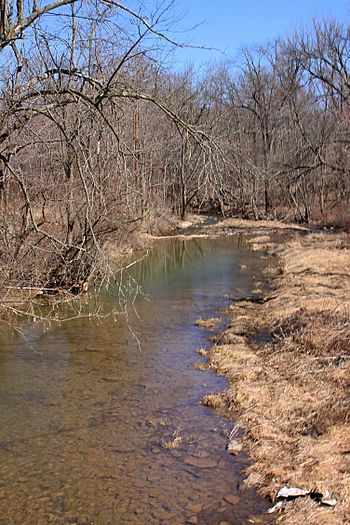Logan Run facts for kids
Quick facts for kids Logan Run |
|
|---|---|

Logan Run looking downstream
|
|
| Physical characteristics | |
| Main source | Shamokin Hill near in Rush Township, Northumberland County, Pennsylvania 960 to 980 feet (290 to 300 m) |
| River mouth | Susquehanna River in Rush Township, Northumberland County, Pennsylvania 440 ft (130 m) 40°56′20″N 76°35′36″W / 40.9389°N 76.5932°W |
| Length | 5.7 mi (9.2 km) |
| Basin features | |
| Progression | Susquehanna River → Chesapeake Bay |
| Basin size | 8.70 sq mi (22.5 km2) |
Logan Run, sometimes called Logan's Run, is a small river that flows into the Susquehanna River in Northumberland County, Pennsylvania. It's about 5.7 miles (9.2 km) long and runs through Rush Township. The area that drains into Logan Run, called its watershed, covers about 8.70 square miles (22.5 km2).
Five bridges cross this stream, and long ago, there was a gristmill and sawmill here. Logan Run is known as a great place for coldwater fish, including those that migrate. You can find different types of rocks, like sandstone and conglomerate, in the area around the stream.
Contents
Where Logan Run Flows
Logan Run starts on Shamokin Hill, which is close to the southern edge of Rush Township. It flows west through a valley for a short distance. Then, it turns north for a little while.
After that, the stream turns northwest, and its valley gets wider and deeper. It continues roughly north for a few miles, and four smaller streams join it. At this point, Logan Run crosses State Route 2004. It then turns northwest for a short distance, and its valley becomes even wider.
The stream then turns north and another small stream joins it. Next, it turns northeast and receives another small stream. It then turns north again, with two more small streams joining it, before heading north-northeast for several tenths of a mile. Here, Logan Run crosses Pennsylvania Route 54. It flows north for a bit longer before finally meeting the Susquehanna River.
Logan Run joins the Susquehanna River about 138.96 miles (223.63 km) upstream from where the Susquehanna River flows into the ocean.
Water, Land, and Rocks
The elevation of Logan Run where it meets the Susquehanna River is about 440 feet (130 m) above sea level. Where the stream begins, its elevation is between 960 feet (290 m) and 980 feet (300 m) above sea level.
You can find beds of rounded boulders along Logan Run at an elevation of 725 feet (221 m) above sea level. There are also sharp, broken pieces of different rock types in this area. These include sandstone and conglomerate. Some of these rock pieces are larger than 2 feet (0.61 m) across. This area has not been affected by glaciers.
Sandstone has also been found in the hills near Logan Run. Logan Run flows into the Susquehanna River on its left bank. Scientists have also found nutrients containing nitrogen in the water of Logan Run.
Logan Run's Watershed
The watershed of Logan Run covers an area of about 8.70 square miles (22.5 km2). This means all the rain and snow that falls in this area eventually drains into Logan Run. The stream is located in the Danville area, according to the United States Geological Survey. It is one of the main streams in Rush Township and is part of the larger Lower Susquehanna River drainage basin.
History of the Area
A gristmill (for grinding grain) and a sawmill (for cutting wood) were built on Logan Run a long time ago by a person named Daniel Montgomery. At one point, a man named John Gilliam operated the mill.
Today, five bridges that are more than 20 feet (6.1 m) long cross Logan Run. Four of these bridges were built in the 1930s, with three of them constructed in 1934 and 1935. For example, a concrete bridge was built in 1930 and is 24.0 feet (7.3 m) long. In 1934, a concrete slab bridge and a steel bridge were built, measuring 21.0 feet (6.4 m) and 32.2 feet (9.8 m) long, respectively. Another concrete bridge, 44.0 feet (13.4 m) long, was built in 1935. The newest bridge was built in 1985; it's 49.9 feet (15.2 m) long and carries Pennsylvania Route 54.
Fish and Wildlife
Logan Run is known as a coldwater fishery and a migratory fishery. This means it's a good place for fish that prefer cold water, and also for fish that travel (migrate) to different places to lay their eggs. You can find fish from the family Salmonidae (like trout or salmon) and other types of coldwater fish living in Logan Run.

